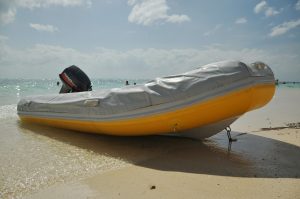So you just bought your first inflatable rubber boat, and to make it last longer, you have to look for some tips, on inflatable boat care and repairs.
If you’re currently in that situation, we’re glad you stumbled on our site! This article is the perfect read for you.
We’re going to show you some of the best inflatable boat care and inflatable boat repair tips including how to clean, how to patch, and how to store an inflatable boat to ensure that your boat will last for decades.
Let’s get started.

Inflatable Boat Care and Maintenance
Boats are high-maintenance vehicles because they spend most of their active time half-submerged in the water. The more time your boat spends sitting at the dock, the more likely it will break down over time.
Here are several things that you can do to keep your inflatable boat in its best shape:
Set a Cleaning Routine
Whenever you want to deflate your boat and pull it out of the water, it’s best to rinse out the outer surfaces with fresh and clean water. The goal is to clean out any chemicals, debris, and other residues left from your trip.
Even though it may not be immediately visible, leaving chemicals on the surface of your inflatable boat could slowly damage it in the future. Saltwater is especially notorious for causing unattended damage over time.
How to Clean an Inflatable Boat
Remember, thorough cleaning and rinsing could prevent crystal formation and other chemicals from seeping into the deck.
Cleaning your inflatable boat is relatively easy. You can use inexpensive house cleaning utensils like brushes and rubber gloves to scrub the debris from its surface. However, you should always use inflatable-boat-specific cleaning products because regular boat cleaning chemicals could be harmful to an inflatable material.
Cleaning Materials to Avoid for Cleaning Inflatable Boats
While most inflatable boats are tough and durable in various conditions, they require special care when you clean them. Aside from picking inflatable-boat friendly cleaning products, you must avoid using these chemicals to clean your boat:
- Acetone
- Bleach
- Steel wool (or other abrasive items)
- Toluene
- Ammonia
- High-alkaline cleaners
- MEK
Using soap and detergent sparingly to clean your inflatable boat is okay, but remember to rinse it well afterward. Leaving excess soapy moisture could lead to mildew and a slippery layer.
Store and Cover Your Inflatable Boat Properly
After you’re done cleaning your inflatable boat, be sure to let it dry out and wipe any water spots from your electronics and dashboard. Although wiping water spots may sound like a chore, it will help your boat to look fresh and shiny the next time you want to take it out for a spin.
If you plan on deflating and folding up your inflatable boat every time you’re done using it, you should know how to store an inflatable boat properly.
Storing a Rigid Inflatable Boat
If you have a rigid inflatable boat (RIB), the best practice for storage is by keeping it inflated. Deflating a RIB for short-term storage or travel purposes is one of the best perks of having one, but keeping them uninflated for a long time is a bad idea.
Inflatable boats are more susceptible to damage when they are not inflated for a long time. When an inflatable boat is not inflated, there are creases and bends all over the body. These bends and creases can lead to weak spots once you inflate them again, which you don’t want to have.
Cover Your Boat
It’s also a good idea to cover your boat whenever you decide to leave them outside under the sun. The UV rays from the sun can slowly degrade the rubber and plastic material from your inflatable boat. Try to cover your inflatable boat with an inexpensive UV-protective tarpaulin made from breathable fabric to keep the sun damage out and prevent mildew.
Store Your Boat Dry
You should also ensure that it’s completely dry whenever you decide to put away your inflatable boat. Leaving any kind of moisture will increase the chance of mildew and mold, which could damage the boat if left unattended.
Avoid High-Temperature Areas
If you keep your inflatable boat out in the water or set it up as a tender on a larger yacht, it’s best to avoid areas with high temperatures. The heat could interact with the inflatable materials, leading to deformation and damage. It’s also best to avoid using a dark cover since it can amplify the heat from the sun.

Inflatable Boat Repairs
Repairing an inflatable boat is a very nuanced process since your boat can suffer various types of damage. But the general rule of thumb is that the repair environment should have less than 60 percent humidity, be dry, well-ventilated, and has a temperature of 18-25°C.
There are several different approaches to repair an inflatable boat depending on its core material. But generally, some items and chemicals always come in handy when repairing an inflatable boat. These materials are:
- Adhesive
- Fabric patch
- Polythene
- Sandpaper
- Primer
- Acetone
Note that some of these materials are not always suitable for the ‘inflatable’ side of your boat, so use them with extra caution.
Finding a Leak in an Inflatable Boat
Leaks and punctures are among the most common problems with an inflatable boat. Here’s how you can find a leak in an inflatable boat:
- Inflate your boat to its maximum pressure.
- Inspect the body of your boat for signs of worn-down surfaces.
- Create a 50:50 mixture of low-pH cleaning agents with warm water.
- Spray the mixture around the boat, and look out for any bubble formation.
- Mark the areas that have leak indications (bubbles).
- Rinse your boat cleanly before proceeding to patch the leaks.
Once you’ve found where the leaks are located, it’s time to repair your inflatable boat.
How to Patch a Leak in an Inflatable Boat
These are the basic steps that you could follow to repair the leaks and punctures in your inflatable boat:
- Find out your boat’s materials. Knowing the material is vital to select the correct patching apparatus.
- If the tear or punctures are smaller than 55mm, a single-layer fabric patch should be enough. More giant tears require multiple layers to repair.
- Locate the tear by using the soap water spray method as explained above.
- Clean the back of the fabric patch to ensure no debris can reduce the adhesive effectiveness. Be sure to let it dry before applying an adhesive.
- Apply the adhesive to the back of the patch and wait for it to dry. After twenty minutes, apply the second layer of adhesive.
- Roll the patch using a piece of polyethylene to get the patch inside the tear.
- Unroll the patch and let the adhesive stick, and cover the tear.
- Place a weight on the newly-patched tear and leave it for around 24 hours.
- Double-check for leaks before re-launching your boat on the water.

Conclusion
Keeping an inflatable boat in its tiptop shape could prolong its life and, in turn, provide more value for you as an owner. Primary care like rinsing your boat with clean water after each use and keeping it dry before putting it away could make a significant difference in your boat’s overall condition. We hope this article has taught you a few things about inflatable boat repair and inflatable boat care.
Related Posts
- The Best Inflatable Boats for 2022
In today's enticing market for inflatable waterborne vessels, you might find it overwhelming to find…
- Finding the Best Inflatable Boat for Fishing
If you are an angler or a fishing enthusiast in general, having the best inflatable…
- Top 4 Inflatable Pontoon Boats
If you're on the lookout for a pontoon boat, you should pick the best inflatable…
